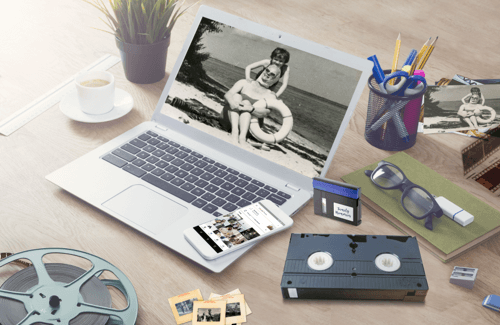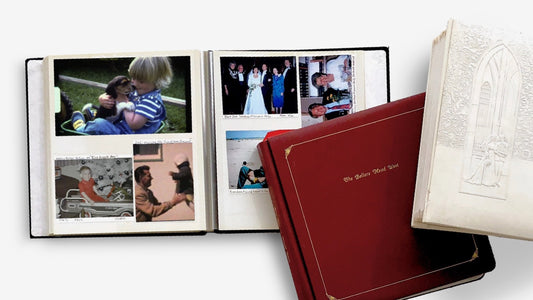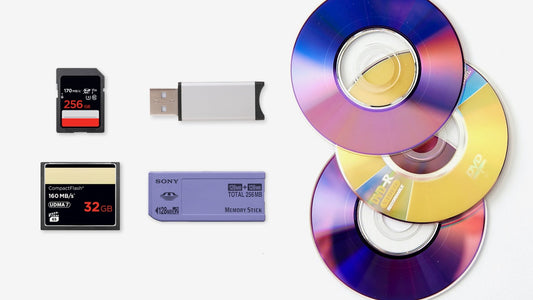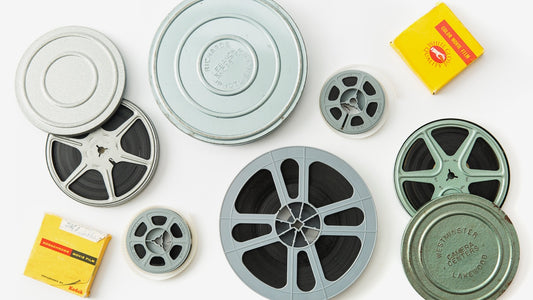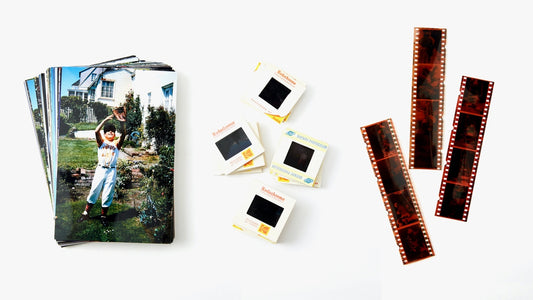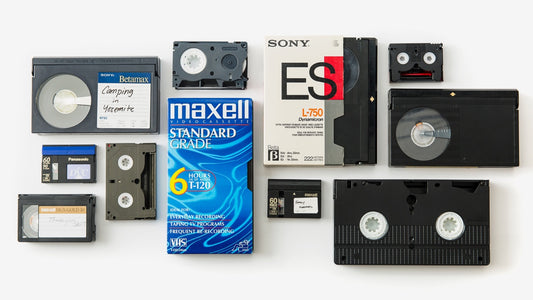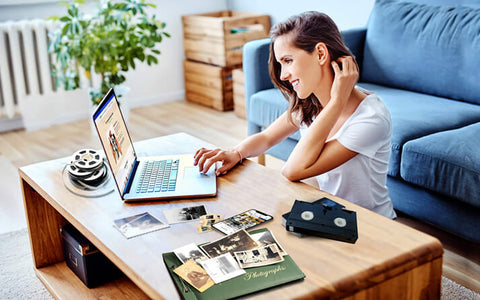Your family’s history is captured on those reels of 8mm film, but time isn't kind to physical media. Those precious memories are vulnerable, fading with each passing year. It's time to convert 8mm to digital and bring them into the present. This is where 8mm film digitization comes in—it’s the best way to safeguard those irreplaceable moments. This guide provides a clear roadmap, helping you choose between professional services and DIY methods, prepare your films, and find the perfect ways to store and share your family's story for years to come.
Key Takeaways
- Preserve your 8mm film memories by digitizing them: Film degrades over time, but digital formats offer a safe, lasting way to protect these precious moments. Consider professional services like YesVideo for expert handling and high-quality transfers.
- Weigh the pros and cons of DIY versus professional digitization: DIY offers control and can be budget-friendly for small collections if you have the technical skills. Professional services provide expertise, convenience, and advanced restoration for a hassle-free experience.
- Share your digitized memories with ease and ensure their longevity: Digital formats allow simple sharing with loved ones through various platforms. Back up your files in multiple locations to safeguard these irreplaceable moments for future generations.
What Is 8mm Film & Why Is Digitization a Must?
8mm film, a staple of home movies and amateur filmmaking since the 1930s, offered families a compact and affordable way to capture precious memories. These reels hold irreplaceable moments, from birthday parties and holidays to everyday family life. However, time takes a toll on this physical medium. Even with careful storage, film reels are susceptible to degradation, causing those precious memories to fade. Color film is particularly vulnerable, as the dyes can break down, diminishing image quality and vibrancy. This is why digitizing your 8mm films is so crucial. Check out our film transfer options.
Converting your 8mm film to digital safeguards your memories against the inevitable effects of aging. Professional digitization services often use specialized scanners that capture each frame individually, allowing for digital restoration and correction of age-related issues like color fading and scratches. This process not only preserves the content for future generations but also enhances the viewing experience. Imagine sharing these revitalized memories with family and friends, reliving those special moments with the clarity and vibrancy they deserve. Digitization makes these memories easily accessible and shareable, ensuring they remain a cherished part of your family history for years to come.
How Does 8mm Film Digitization Actually Work?
Digitizing 8mm film involves converting your old reels into a modern digital format like MP4. This process typically uses specialized equipment to capture each frame of your film and convert it into a digital file. There are several ways to accomplish this, from professional services to DIY methods, each with its own pros and cons, which we'll cover later. First, let's discuss quality and some common misconceptions.
What Determines the Quality of Your Digital Copy?
The quality of your digitized 8mm film depends on several factors, including the original film condition, the equipment used in the transfer process, and the chosen digital format. The film itself holds a surprising amount of detail—the equivalent of 1000-1200 lines of horizontal resolution—and high-definition digital formats like MP4 can capture that detail much better than a standard DVD, as YesVideo explains. Opting for higher resolutions ensures your memories are preserved in the best possible quality for future generations. Beyond resolution, consider factors like color correction and stabilization, which can significantly enhance the final product. A professional service like YesVideo can often address these aspects more effectively than DIY methods. Preserving your 8mm film is a key benefit of digitization. As Rementus points out, film degrades over time, especially if not stored correctly. Converting to digital safeguards your memories, ensuring they remain vibrant and accessible for years to come.
Common Digitization Myths and How to Avoid Them
One common misconception is that all 8mm film digitization services offer the same quality. However, the results can vary dramatically depending on the equipment and expertise of the provider. Another misconception is that old film reels are beyond saving. While film reels do degrade over time, even with optimal storage, much can be done to restore and preserve even significantly aged film. Color fading is another common issue, especially with color films. The dyes in the film can break down, leading to a loss of image quality and vibrancy, as explained by Video Conversion Experts. Professional services often have techniques to mitigate this and restore some of the original color. Finally, some believe that digitizing 8mm film is overly complex. While the process requires specialized equipment, the core concept is simple: convert the film into a format viewable with today's technology, as noted by Reborn Audio Video. Whether you choose a professional service or a DIY approach, the goal is the same—to preserve your precious memories.
Pro vs. DIY 8mm Digitization: Which Is Best for You?
Deciding how to digitize your 8mm films involves weighing several factors. Do you prioritize convenience and expertise, or are you comfortable with a more hands-on approach? Let's explore the pros and cons of professional digitization services versus DIY methods to help you make the best choice.
Why You Might Hire a Professional Service
Professional services like YesVideo offer a hassle-free experience. You simply send in your films, and experts handle the entire process. This is especially appealing if you have a large collection or delicate films that require careful handling. Pros use specialized equipment like high-resolution film scanners and advanced software to ensure the best possible quality. These labs capture each frame individually, allowing for color correction and other enhancements to restore faded or damaged footage. Plus, professional services often include options for organizing and storing your digital files, simplifying the process even further. This ensures your memories are preserved for future generations, especially since film can degrade over time.
Handling a Wide Variety of Film Formats
If you’ve inherited a box of old home movies, you might find a mix of different film types. Beyond the standard 8mm, there’s Super 8 and even 16mm film, each with its own unique specifications. Figuring out what you have can be confusing, let alone finding the right equipment to digitize it. Professional services eliminate this guesswork. They have specialized equipment and trained technicians who know exactly how to handle each format. Some older films even have sound strips, and a professional service can ensure that audio is captured along with the video. Entrusting your collection to experts means you don't have to worry about the technical details; you can just look forward to seeing your memories again.
Access to Advanced Restoration and Quality Options
One of the biggest advantages of using a professional service is the incredible quality of the final product. While DIY converters exist, they often can't match the high-resolution options, like 1080p or 2K, that professional labs provide. These higher resolutions capture more detail from your original film, resulting in a much clearer and more vibrant digital copy. Beyond resolution, professionals offer advanced restoration services. They can digitally clean up dust and scratches, stabilize shaky footage, and perform color correction to bring faded films back to life. This level of enhancement can make a world of difference, transforming aged footage into something that looks like it was filmed much more recently.
A Secure and Trackable Process
Sending your one-of-a-kind family films through the mail can feel nerve-wracking, and that’s completely understandable. Reputable digitization companies recognize this and have built secure, transparent processes to give you peace of mind. At YesVideo, for example, we process every order by hand right here in the USA, so your precious memories are never outsourced. We provide a trackable system that gives you updates throughout the entire process, from the moment your films arrive at our facility to the moment they’re safely shipped back to you. Knowing your memories are in trusted hands allows you to relax while the experts get to work preserving your family’s history.
Expert Film Handling and Organization
Over the decades, film can become brittle and fragile. Handling it requires a delicate touch and a bit of expertise to avoid causing damage. Professional technicians are trained to work with aged film, carefully cleaning and repairing minor issues like old splices before the transfer process begins. This careful handling ensures the best possible scan. If you have a large, unlabeled collection, a professional service can also be a lifesaver. They can help organize your reels, creating a logically structured digital archive that’s easy to browse. This service goes beyond simple conversion; it’s about providing expert care for your irreplaceable memories from start to finish. You can learn more about our film transfer process on our website.
The Rewards of a DIY Digitization Project
Digitizing your 8mm films yourself gives you complete control. You choose your own equipment, software, and file formats, tailoring the conversion to your specific needs. Initially, DIY conversion appears less expensive than professional services. A converter can be a one-time purchase, but factor in the hidden DIY costs: your time, potential software costs, and the risk of damaging precious films. This approach works well for tech-savvy individuals with smaller collections and a willingness to invest the necessary time and effort. Keep in mind that film reels degrade, even in optimal storage conditions, so handling them requires care.
Understanding the Risks of DIY Converters
While the idea of a DIY project is appealing, it's important to understand the potential pitfalls of using at-home converters. These devices often produce subpar results, yielding digital files that lack the clarity and detail of a professional transfer. The quality of your final video is heavily influenced by the equipment used, and consumer-grade scanners simply can't match the technology used by experts. Beyond lower quality, there's a real risk of damaging your irreplaceable films. Some DIY converters can overheat or handle the delicate film too roughly, potentially causing permanent harm. You'll also need to be prepared for post-production work, as you'll likely have to use video editing software to correct issues with color, speed, and shaky footage. For those who want to ensure the best possible outcome and safeguard their memories, a professional film transfer service is often the most reliable choice.
Breaking Down the Costs: Pro vs. DIY
While DIY might seem cheaper upfront, the actual cost can vary. Professional services typically charge per foot of film or per reel. Some services offer competitive rates around $0.34 per foot for 8mm film conversion. Others, like YesVideo, charge per tape, with prices averaging around $22. DIY involves the cost of equipment, which can range from basic converters for around $20 to more advanced film scanners costing hundreds of dollars. Remember to consider the value of your time and the potential for costly mistakes when comparing DIY to professional services. If you have a large or irreplaceable collection, the peace of mind and expertise offered by a professional service might be worth the investment.
Comparing Professional Service Pricing Models
When you start exploring professional services, you'll notice a couple of common pricing structures. Many companies charge by the length of the film, typically per foot, with rates often ranging from about $0.34 to $0.62. This can be a cost-effective route, but it means you'll need to figure out the length of your film reels first. For a more straightforward approach, some services, including YesVideo, charge a simple flat rate per tape. This makes it much easier to calculate the total cost upfront without any guesswork. It's also a good idea to keep an eye out for bulk discounts or special offers, which some companies like Kodak Digitizing provide to help make larger projects more affordable. While professional digitization is an investment, you're paying for expert handling, superior quality, and the invaluable peace of mind that comes with entrusting your irreplaceable memories to capable hands.
The Best Professional 8mm Digitization Services Reviewed
Choosing a professional service to digitize your 8mm films can save you time and ensure high-quality results. Several companies specialize in these conversions, each with its own strengths. Here’s a rundown of some popular options to explore:
YesVideo
YesVideo handles the entire digitization process, making it a convenient choice for various old media formats, including 8mm film. Learn more about their video transfer services.
Legacybox
Legacybox focuses on digitizing home movies, including 8mm and Super 8 film, offering several digital output options like DVDs, cloud storage, and thumb drives. See their 8mm film transfer page for details.
Southtree
Southtree handles various analog media, including 8mm film, emphasizing quality control and a hands-on approach to preserving your memories. Explore their services.
iMemories
iMemories offers a customer-focused experience for digitizing various media formats, aiming to make the process smooth and easy. Find more information on their website.
Kodak Digitizing
Kodak Digitizing leverages its film expertise to offer Super 8 film-to-DVD transfers, highlighting their history with the format. Learn more about their Super 8 transfer options.
Forever Studios
Forever Studios specializes in high-definition 8mm and 16mm film transfers, using AI enhancements to improve the quality of digitized films. Visit their website for more information.
CVS Photo
CVS Photo offers a convenient local drop-off option for 8mm film digitization, providing various output formats like DVDs and USB drives. Find details about their video transfer services.
Walmart Photo
Walmart Photo provides film transfer services, including 8mm film, offering another accessible option for digitizing memories. Check their film transfer page for more information.
How to Digitize 8mm Film at Home: Your Guide to Gear and Methods
Want to digitize your 8mm film yourself? It's definitely possible, and seeing those old memories come to life on a modern screen can be incredibly rewarding. There are a few different methods you can use, each with its own pros and cons. Let's explore the equipment and processes involved.
Method 1: Using a Projector and Digital Camera
This method involves projecting your 8mm film onto a screen and capturing it with a digital camera. You'll need a working 8mm film projector and a high-quality digital video camera. Set up your projector and aim it at a screen, just like you would have years ago. Then, use your digital camera to record the projected movie. This method can be tricky. Lighting and focus are crucial for a clear image, and you'll need a steady hand (or, even better, a tripod) to avoid shaky footage. Reborn Audio Video explains that converting the film makes it compatible with current technology.
Method 2: Using a Dedicated Film Scanner
Film scanners offer a more direct approach. These devices scan each frame of your 8mm film, creating digital images that software then combines into a video file. Rementus highlights the biggest advantage of digitizing old film: preservation. Physical film degrades over time, but digital files ensure your memories are safe. Film scanners range in price and quality, so research to find one that meets your needs and budget. Some scanners offer helpful features like dust and scratch removal, significantly improving the final video quality.
Method 3: Using an All-in-One Converter
For a simpler experience, consider an all-in-one conversion device. These gadgets combine a projector or scanner with built-in software to simplify digitization. Amazon offers a wide selection, with various features and prices. Most convert 8mm film directly to digital MP4 files, readily viewable on most devices. If you want a hassle-free DIY method, this might be the best option. If you'd prefer to leave it to the pros, a professional service like YesVideo handles the entire process for you.
Popular All-in-One Converter Models
If you're looking for a straightforward DIY approach, all-in-one converters are a great choice. These devices, like the popular Wolverine MovieMaker Pro or Magnasonic models, combine the scanner and software into one simple machine. They are designed to be user-friendly, converting your 8mm film directly into a digital MP4 file that you can save to an SD card. This means you can immediately watch your newly digitized memories on a computer, TV, or other modern device. While these converters offer a simple path, remember that the quality can vary. For those who want to ensure the highest quality without the learning curve, a professional film transfer service handles all the technical details for you.
Checking Film Reel Size Compatibility
Before you purchase a DIY converter, there’s one crucial detail to confirm: reel size compatibility. Your 8mm films are likely on reels of various sizes, commonly 3, 5, or 7 inches in diameter. Not all home converters can accommodate larger reels, so it's essential to check the product specifications to make sure the device you choose can handle your entire collection. This information is usually listed clearly in the product description or user manual. Getting this wrong could mean you’re unable to digitize your most important films. If you have a mix of reel sizes and want to avoid any compatibility issues, a professional service like YesVideo is equipped to handle all standard film reel sizes, ensuring every memory is preserved.
What Features Ensure a High-Quality Digitization?
When converting your precious 8mm films to digital, several key features determine the final quality. Understanding these elements helps you make informed decisions, whether you choose a professional service like YesVideo or opt for the DIY route.
Getting a Sharp Image: Resolution and Quality
8mm film holds a surprising amount of detail. High-definition digital formats like MP4 capture that detail much better than standard DVDs. Aim for at least 1080p resolution (or 1920x1080 pixels) to preserve the richness of your original film. Professional services ensure the highest quality transfer, safeguarding those precious memories.
Ensuring Smooth Playback: Frame Rate Explained
8mm film was typically shot at 16 or 18 frames per second (fps). While maintaining the original frame rate preserves the authentic look, converting to a higher frame rate like 24 or 30 fps can create smoother playback. Discuss frame rate options with your chosen service or adjust settings accordingly if you're digitizing yourself. This ensures your digital movies will play smoothly on any device.
What About the Audio? Capturing Sound from Your Film
If your 8mm film includes sound, ensure the digitization process captures the audio clearly. Professional labs often use specialized equipment and software to capture and potentially restore audio, minimizing any background noise or distortion. Frame-by-frame scanning with restoration software can significantly improve the quality of older film.
Choosing the Right Digital File Format
The most common digital file formats for 8mm film conversion include MP4, MOV, and AVI. MP4 generally offers the best balance of quality, file size, and compatibility. Consider your intended use for the digitized files (e.g., online sharing, archiving, editing) when selecting the appropriate format. Digital formats ensure your memories are preserved for future generations.
How to Prepare Your 8mm Films for Digitization
Before sending your 8mm films off for digitization, a few preparatory steps can significantly impact the final result. Think of it like prepping ingredients before a great meal—a little upfront work makes all the difference.
First, carefully assess the condition of your films. Check for any physical damage like scratches, tears, or warping. Also, note any discoloration or fading. Knowing the state of your films helps you set realistic expectations and allows the conversion service to handle any potential issues. Learn more about assessing film conditions.
Dust and dirt inevitably accumulate on film. Gently wipe the film reels with a soft, lint-free cloth to remove any debris. This simple cleaning can dramatically improve the quality of the digital conversion. Find detailed cleaning instructions. Organizing your films before sending them for conversion streamlines the entire process. Sort your reels chronologically or by event, and label each clearly. This ensures your memories are digitized in the correct order, preserving the flow of events. Explore different organization methods.
Finally, proper storage is crucial. Keep your films in a cool, dry place, away from extreme temperatures and humidity, which can cause further damage. This article offers helpful storage tips. By taking these steps, you'll ensure your precious memories are ready for their digital transformation.
Preview Your Reels to Prioritize Content
Before you send your films away, taking a moment to preview them can make a huge difference. Think of it like prepping ingredients for a favorite recipe—a little effort upfront ensures a better outcome. Watching your reels helps you identify the most important moments you want to preserve. You might find that some reels are duplicates or contain footage that isn't as meaningful, which can help you prioritize if you're working with a budget. It also gives you a chance to assess the film's condition. As experts suggest, checking for damage like tears or fading helps you set realistic expectations for the final digital version. This step isn't just about logistics; it's about curating your family's story and ensuring the most cherished memories get the attention they deserve.
Get Quotes from Multiple Services
Once you've decided to use a professional service, it's smart to shop around. Not all digitization companies are the same, and getting a few different quotes will help you find the best fit for your needs and budget. When you compare services, don't just look at the cost per foot. Consider what's included in the price, such as the final resolution, digital delivery options (like cloud access or a USB), and turnaround time. For example, at YesVideo, we provide a secure, trackable process so you always know where your precious memories are. Getting multiple quotes is a common tip among those who've gone through the process, as it helps you find the best value—a combination of quality, security, and price that gives you peace of mind.
Your Films Are Digitized. Now What?
Once your 8mm films are digitized, you have a wealth of options for preserving and sharing those precious memories. It's like opening a time capsule and rediscovering your family history. Now, let's ensure these memories remain safe and accessible for generations to come.
How to Safely Store and Back Up Your Memories
Converting 8mm film to digital safeguards your memories from degradation and loss. Unlike physical film, digital formats aren't susceptible to the same wear and tear, making them ideal for long-term storage. Think of it as future-proofing your family history. You can store your digitized files on various devices, from external hard drives and USB flash drives to cloud storage services. YesVideo offers MemoryCloud access with their transfer service, allowing you to view, download, and even share your memories directly to platforms like Google Photos.
Having multiple backups is key. Consider the 3-2-1 backup strategy: three copies of your data on two different media types, with one copy stored offsite. This redundancy protects you from hardware failures, accidental deletions, and even natural disasters.
Considering Long-Term Archival Storage
Think of your digital files as the new family archive. To ensure these memories last for generations, it’s smart to adopt a robust storage plan. A great rule of thumb is the 3-2-1 backup strategy: keep at least three copies of your files, on two different types of media, with one copy stored offsite. For example, you could save your digitized movies on your computer’s internal drive, back them up to an external hard drive, and use a cloud storage service for your offsite copy. This simple system provides powerful protection against hardware failure, accidental deletion, or even a local disaster. Properly storing your files is the final, vital step in the film transfer process, guaranteeing your family’s story remains safe and accessible for years to come.
Simple Ways to Edit and Enhance Your New Digital Videos
Digitizing your 8mm films is more than just preservation; it's an opportunity to enhance and revitalize your memories. Professional digitization services often use sophisticated software to correct the effects of aging, like color fading and scratches, breathing new life into old footage. Professional labs use scanners that capture each frame individually, allowing for detailed restoration. The detail held within 8mm film is remarkable, and high-definition digital formats like MP4 can truly capture its richness. As YesVideo points out, 8mm film holds the equivalent of 1000-1200 lines of horizontal resolution.
Once your films are digitized, you can use readily available software to edit, enhance, and share your memories. You can create highlight reels, add music, or even correct shaky footage, making your family history even more vibrant and engaging. Digital files offer flexibility for sharing, whether creating DVDs, uploading to social media, or simply emailing clips to family and friends.
What to Do with Your Original Film Reels
After you’ve digitized your films, you might wonder what to do with the original reels. The short answer: absolutely keep them. Think of your original films as the irreplaceable master copies of your family's history. While digital files are fantastic for sharing and viewing, digital storage isn't foolproof—hard drives can fail and cloud services can change. Your physical reels are the ultimate backup. That’s why professional services like YesVideo always send your original media back to you along with your new digital copies. To ensure they last, store your reels in a cool, dry place away from extreme temperatures and humidity. Keeping them organized and clearly labeled will also make them easy to find if you ever want to revisit them or re-scan them with future technology.
Making the Right Choice for Your 8mm Films
Deciding how to convert those reels of 8mm film to digital can feel overwhelming. Do you tackle it yourself or trust a professional service? Let's break down the factors to consider so you can make the best choice for your precious memories.
First, think about the condition of your films. Have they been stored carefully or subjected to less-than-ideal conditions? Film degrades over time, even with proper storage, so understanding their current state is key. This will influence whether a DIY approach is feasible or if professional handling is necessary.
Next, consider your technical skills and available equipment. Converting film at home requires some technical know-how, along with specific equipment like a projector, camera, or scanner. If you're not comfortable with this process, a professional service like YesVideo offers a hassle-free experience. They handle everything, ensuring your films are treated with care and expertise.
Your budget also plays a role. DIY methods might seem cheaper upfront, but hidden costs can add up. Factor in the price of equipment, software, and the time investment involved. Professional services offer various pricing tiers, often bundling services and providing digital copies, cloud storage, and other features. Compare services to find the best fit for your needs.
Finally, think about the value of your memories. These films hold irreplaceable moments, and professional services specialize in high-quality transfers using advanced equipment and techniques. They can often restore faded colors and improve image quality, breathing new life into your old films. This expertise ensures your memories are preserved in the best possible way for generations to come. Digitizing your 8mm film safeguards these precious moments, allowing you to easily share them with loved ones and relive those special times.
What About Undeveloped 8mm Film?
If you've stumbled upon a canister of 8mm film that's never been developed, you're holding a true time capsule. Unlike the home movies you've already seen, this film needs to go through a chemical development process before any images can appear. This is a specialized service that's different from the digitization process we've been discussing for already-viewable films. Think of it as the first, crucial step to revealing the hidden memories on the reel. The development process uses specific chemicals to make the latent image on the film visible, a delicate procedure that requires a professional lab with the right equipment.
Attempting this at home is not recommended, as the chemicals can be hazardous and the process is highly technical. Many older film stocks, especially Kodachrome, require very specific, and now rare, processing methods. Only after the film is properly developed can it be viewed, projected, or converted into a digital format. Finding the right lab to handle this delicate process is key to successfully recovering what's on the film. Once developed, you can then send the reels to a service like YesVideo to create a lasting digital copy you can share with your family.
Finding a Film Development Service
Finding a reliable lab to develop your film is essential. You'll want a service that specializes in older film formats and has a strong reputation. Several professional labs offer mail-in services, making the process convenient. For example, Pro8mm is known for its comprehensive processing of various Super 8mm film stocks, including Kodak and Fuji. If you suspect your film is expired, a service like Negativeland can handle both current and expired 8mm and Super 8 film. You can also send your film to The Darkroom, another trusted mail-in option that develops a wide range of formats. When choosing a service, be sure to read customer reviews, compare their pricing, and check their turnaround times. Most importantly, confirm they can process your specific type of film to ensure your memories are handled with care.
Related Articles
- 8mm to DVD: Top Conversion Services & DIY Guide – YesVideo
- Film Transfer – YesVideo
- Convert VHS to Digital: The Ultimate 2024 Guide – YesVideo
- Negative Photos 101: A Comprehensive Guide – YesVideo
- YesVideo's Film Transfer - Transfer Old Film Reels to Digital
Frequently Asked Questions
Why is digitizing old 8mm film important? 8mm film degrades over time, losing color and clarity. Digitizing preserves those precious memories in a stable format, protecting them from further damage and making them easily accessible. It's like giving your memories a fresh start.
What's the difference between using a professional service and digitizing 8mm film myself? Professional services offer expertise and specialized equipment, resulting in high-quality conversions and often include extras like color correction and digital enhancements. DIY methods offer more control over the process and can be less expensive initially, but require technical skills and the right equipment. It's about convenience versus control.
How much does 8mm film digitization cost? Professional services typically charge per foot of film or per reel, with prices varying depending on the company and any additional services. DIY costs involve purchasing equipment, which can range from affordable to quite expensive depending on the features and quality. Consider the value of your memories and the level of quality you desire.
What are the best ways to store digitized 8mm film? External hard drives, USB flash drives, and cloud storage services are all viable options. The key is to have multiple backups to protect against data loss. When you convert film to digital, storing your files securely is like an insurance policy for your memories.
How can I share my digitized 8mm films with family and friends? Digital files offer incredible flexibility. You can create DVDs, upload to social media platforms like YouTube or Vimeo, share through cloud storage services, or simply email clips to loved ones. Sharing these memories strengthens family connections and keeps those stories alive.





